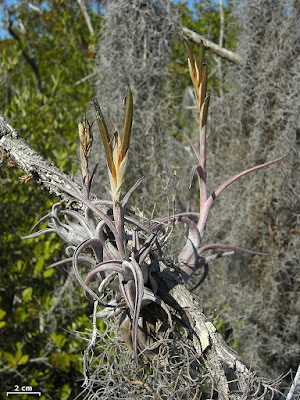Tillandsia paucifolia is native to Central America, central and southern Mexico, Venezuela, Colombia, the West Indies, and Florida. It is found at an altitude ranging from 0 to 1000 meters above sea level. This species is often confused with Tillandsia caput medusae.
Tillandsia paucifolia, also called as The Potbelly air plant, Tillandsia bracteosa, Tillandsia yucatana, is a species of the genus Tillandsia. This species was described by John Gilbert Baker in 1878.
IDENTIFY TILLANDSIA PAUCIFOLIA AIR PLANT
Tillandsia paucifolia is native to Central America, central and southern Mexico, Venezuela, Colombia, the West Indies, and Florida. It is found at an altitude ranging from 0 to 1000 meters above sea level. This species is often confused with Tillandsia caput medusae.
It is a large sized, single or clustering epiphyte species with 5-10 leaves which are many-ranked, recurved to twisted, silvery gray, to 0.3-0.6 cm, grayish-scaly. The sheath nearly chestnut brown within, ovate, conspicuously inflated, forming small pseudobulb, 1.5-3.5 cm wide.
The Potbelly air plant bloom in spring - summer from the single or digitized inflorescence. The bracts of the flowering stem resemble leaves and are imbricate. The primary bracts are scaly and reddish green. The floral bracts are very scaly, green and imbricate. The flowers are sessile, tubular, 4 cm long, purple, more or less pale. The stamens and the pistil are exserts.
TILLANDSIA PAUCIFOLIA AIR PLANT CARE AND CULTURE
Cultural information should only be used as a guide, and should be to be adapted to suit you. Your physical location; where you grow your plants, how much time you have to devote to their care, and many other factors, will need to be taken into account. Only then can you decide on the cultural methods that best suit you and your plants.
Light:
Tillandsia paucifolia requires good light, even full sun (avoid the afternoon in summer if the plant is young or has not been used). You can also cultivate them in partial shade.
Temperature:
The required temperature ranging from 10 to 32°C. Get it early enough in the fall if you grow it outside, so that it does not face night temperatures below 6 ° C, especially if it is wet. The plants can faced temperatures close to 0 ° C (sheltered and dry) for a few hours without damage.
Humidity:
The Potbelly air plant need the moderate level of humidity. This species can withstand short periods of drought. Good aeration is required, the plant must dry quickly (in less than an hour).
Substrate, growing media and repotting:
Tillandsia paucifolia refer to be mounted on a solid substrate that does not retain water. Place the plant very close to a window indoors in the winter and preferably outside the summer in a sunny situation. You can glue the plant directly to the surface with a strong adhesive, or you can wire the plant to the base. Don't cover the base of the plant with moss or it may rot. It can be grown on almost any imaginable decorative mount, including shells, rocks, slate, driftwood, etc.
Watering:
Two or three times a week in summer, one or two times a week in winter according to the luminosity and the ambient humidity. Obviously when it rains and if you grow it outside, it counts as a watering. It will prefer to be grown in an inclined position, to limit the problems of stagnant water at the base of the leaves. If you prefer to cultivate it suspended, turn it over for a few seconds to drain the excess water after each watering.
Fertilizer:
This air plant can be fertilized with the moderate doses. 1 to 2 times a month in the summer and 1 time a month in the winter.















COMMENTS